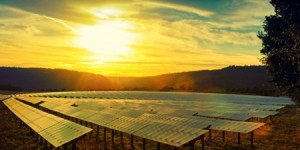
First an Amazing fact, did you know? amount of sunlight that strikes earth’s surface in 90 minutes is enough to provide the entire world’s energy consumption for 24/7 for 365 days. Solar energy is the cleanest, most abundant, renewable energy source available anywhere in the world. Simply speaking solar energy is the energy created from heat of the sun. There are a variety of technologies that are used to derive energy from sun.
Solar energy technology converts sunlight into electricity, either directly using Photo Voltaic technology or indirectly via Concentrated Solar Power technology are the most important such technologies alongside other similar technologies. There are variety of technologies that have been developed to take advantage of solar power. Solar energy technologies use sun’s energy and light to generate heat, electricity, light, hot water, and even cooling for house, business, and industry.
Solar panel converts sunlight to solar energy using N-type or P-type semiconductor material. When sunlight is absorbed, the solar energy lets electrons loose from atoms, allowing electrons to flow through and produce electricity. The process of converting sunlight to electricity is called photovoltaic effect. Currently commercially available solar panels convert most of the visible light spectrum and nearly 50% of ultraviolet/infrared light spectrum to solar energy.
The concentrating solar power, or CSP is used primarily in very large power plants and is not meant for residential use. This technology uses mirrors to reflect and concentrate sunlight to a receiver that collects solar energy and converts it to heat, which is then used to produce electricity. Lets us take a look at the various solar technologies in use to derive maximum benefit from the sun.
Solar Process Space Heating and Cooling
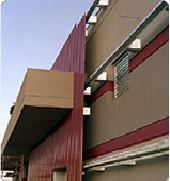
A transpired collector installed in a building
Commercial buildings may use solar technologies like photovoltaics, water heating, daylighting, passive heating that are also used in residential buildings as well as technologies that are impractical for use in home. Ventilation air preheating, solar process heating, and solar cooling are some of those technologies. It may be known that large buildings need ventilated air to maintain indoor air quality. In colder environments, heating air consumes large amounts of energy. However a solar ventilation system using a transpired collector that includes a thin, black metal panel mounted on south-facing wall to absorb sun’s heat can preheat the air, saving both energy and money.
Air passes through many small holes in the panel, space behind the perforated walls allow air stream from holes to mix. This heated air is then sucked out and into the ventilation system. This way solar process heating systems provides hot water or space heating for non-residential buildings. The heat from a solar collector can also be used to cool a building. Solar energy can also be used with evaporative coolers (also called water coolers) to extend their use in a more humid climate. The two main types of solar collectors are an evacuated-tube collector and a parabolic-trough collector.
Hybrid Solar Energy
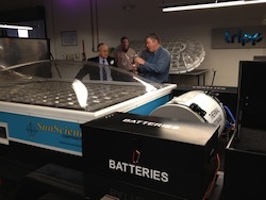
Hybrid Solar Energy combines solar power with wind energy or geothermal heat pumps. Hybrid Solar using “cogeneration” concept capitalizes on the inefficiency of PV solar panels (ranging 15-20%) and captures the wasted heat that is thrown off to heat the water, resulting in 4-5 times the amount of total energy compared to PV panel alone. A hybrid solar energy system usually consists of two or more renewable energy sources used together to provide increased system efficiency as also greater balance in energy supply. Normally Hybrid Solar Energy finds maximum use with industries. Combination of Biomass-wind-solar-fuel cell or a simply photovoltaic – wind energy are examples of hybrid solar energy.
Active Solar Energy
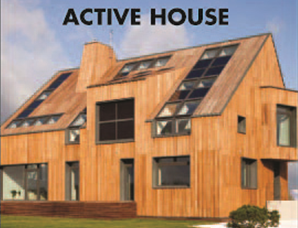
Active solar energy includes installation of electrical/mechanical devices such as solar panels or thermal energy set-ups to create electricity, heat water, or heat space. For example Solar hot water systems use pumps or fans to circulate fluid (often mix of water and glycol to prevent freezing in winter) or air, through solar collectors. Systems that use Active solar energy can be added on to a home or building after it is already built, but are best when incorporated into new construction. The benefit of active solar technology is that electrical controls can be used to maximize their effectiveness.
Using sensors and pumps, small amount of energy can harvest large amount of thermal energy by switching on as soon as a useful temperature differential becomes apparent. Most solar collectors are fixed in their array position mounting, but can have higher performance if they track the sun’s path. Active Solar Tracking systems use sensors and motors to track the path of the sun across the sky. Solar trackers use active solar technology and can generate more energy yield over a period as compared to a fixed array. It can be caused by geographical and time data being programmed into the controls.
Passive Solar Energy

Passive solar energy involves using sun’s radiation to increase natural heating benefits of the sun or minimize them. This is achieved when a structure is being built or windows are being fitted. The basic idea is to have windows south-facing to allow the sun’s heat into the rooms in colder climates. In case of warmer climate its best to have smaller windows facing south and larger windows north-facing. Under passive solar energy design called direct gain the south side of a building that always receives the maximum sunlight usually have large, south-facing windows. Materials that absorb and store sun’s heat can also be built into sunlit floors and walls. The floors and walls heat up during day and slowly releases heat during night hours, when it is needed the most.
Other passive solar design called sunspaces and trombe walls are used to maximize the use of sun rays. In sunspace design like a greenhouse built on the south side of building sunlight passes through glass or other glazing, it warms the sunspace. A proper ventilation system allows the heat to circulate into the building. A trombe wall, made of heat absorbing material is a thick, south-facing wall, that is painted black. A glass pane installed few inches in front of wall holds the heat. The wall heats up slowly in the day, cools gradually at night.
Concentrated Solar Power
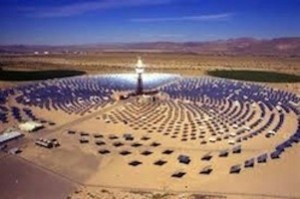
Many power plants use fossil fuel to boil water. However, new generation power plants, use sun as a heat source. There are 3 main types of concentrating solar power systems: parabolic-trough, dish/engine, and power tower. Parabolic-trough systems concentrate sun’s energy through long rectangular, curved (U-shaped) mirror. The mirror is tilted towards sun, focusing sunlight on a pipe that runs down the centre and heats the oil flowing through the pipe. The hot oil boils the water in a conventional steam generator to produce electricity. Dish/engine system uses a mirrored dish-shaped surface to collect and concentrate sun’s heat to a receiver that absorbs heat and transfers it to fluid within the engine.
The heat causes the fluid to expand against a turbine to produce mechanical power that runs a generator to produce electricity. A power tower system uses a large field of mirrors to concentrate sunlight onto top of tower that houses a receiver. This concentrated sunlight heats molten salt flowing through the receiver. The salt’s heat is used to generate electricity via a generator. As molten salt retains heat efficiently, it can be stored for days before being converted into electricity; meaning electricity can be produced on cloudy days or many hours after sunset.
Concentrated Photovoltaic (CPV) is newer form of electricity production competing directly with utility-scale PV and CSP solar arrays. The CPV advantage over these systems involves a smaller footprint because solar panels are made of multi-junction solar cells with concentrating lens, rather than flat silicon cells. The result is increased efficiency greater than traditional PV panels. Therefore less land space is required. As per Current trend CPV systems are located in high-DNI (direct normal irradiance) areas such as southwest USA, Mexico, Chile, Mediterranean nations.
Solar Hot Water
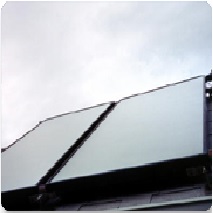
Flat-plate solar hot water systems installed facing south on rooftop
The shallow water of a lake is usually warmer than deep water as sunlight can heat the lake bottom in the shallow areas, which in turn, heats water. The sun is used in the same way to heat water used in buildings and swimming pools. Most solar water heating systems are flat-plate collectors & have two main parts: a solar collector and a storage tank. Mounted on the rooftop, the solar water heater consists of a flat, thin, rectangular box with a transparent cover that faces the sun. Small tubes run through the box and carry either water or other fluid, such as antifreeze solution to be heated. The tubes are attached to a black painted absorber plate to absorb the heat. As heat builds up in the collector, it heats the fluid passing through the tubes.
The storage tank holds the hot liquid. It can be a modified water heater, but its usually larger and is very well-insulated. Systems that make use of fluids other than water, usually heat the water by passing it through a coil of tubing in a tank full of hot fluid. Solar water heating systems can be either active or passive, but the most common are active systems. Swimming pool systems are relatively simple. The swimming pool’s filter pump is used to pump the water through a solar collector, generally made of black plastic or rubber. Also the pool stores hot water.
Photovoltaic (Solar Cell) Systems
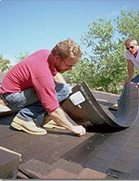
Solar shingles are installed on a rooftop
Photovoltaic materials and devices convert sunlight directly into electricity. A single PV device is called a cell typically producing 1 or 2 watts of power. In order to boost power output they are connected together in chains, creating larger units called modules or panels. Modules can be used individually, or connected to form arrays. One or more arrays connected to the electrical grid creates a complete photovoltaic system. Solar cells are made of semiconducting materials similar to those used in computer chips and often less than the thickness of four human hairs.
When sunlight is absorbed by the solar cells, solar energy knocks electrons loose from their atoms, allowing electrons to produce electricity. This process of converting sunlight (photons) to power (voltage) is called photovoltaic (PV) effect. Solar cells are typically joined in modules of 40 cells; these modules joined in a array can measure up to several meters. These flat-plate arrays can be mounted on a fixed angle facing south, or on a tracking device that follows the sun, allowing them to capture maximum sunlight in a day. Several connected PV arrays can provide enough power for a household; for large electric utility or industry.
Thin film solar cells use layers of semiconductor materials that are few micrometers thick. It has allowed solar cells to double up as rooftop shingles, roof tiles, building facades, or glazing for skylights. Some solar cells are designed to operate with concentrated sunlight. These are built into concentrating collectors that use lens to focus sunlight onto cells. The idea is to use very little of the expensive semiconducting PV material while collecting as much sunlight. But as the lens must be pointed at the sun, use of concentrating collectors is limited to the sunniest parts of the country. Solar cells are. In order to withstand the outdoors for many years, cells are sandwiched between protective materials in a combination of glass and/or plastics.
Vivaan Solar believes that all-though these solar technologies are viable, useful and help cut greenhouse gas emissions; however which type of technology is suitable for use at a particular region depends on many factors. These factors chiefly include end user preferences, aesthetics, and commercial viability among others. While some solar technologies have long gestation period others may have a rather short gestation period that may ultimately decide the use of any of these solar technologies.

Reading your site is pure pleasure for me, it deserves to go viral, you need some initial traffic only.
If you want to know how to get it search for: blackhatworren’s strategies
dear sir/madam
thanks for the appreciation for writing a good blog.
we like to share useful information through blog about solar power and renewable energy and technology.
do share our blog with your friends and spread the word.
keep watching this space for the latest blog updates.
I see your page needs some unique & fresh content.
Writing manually is time consuming, but there is tool for this
task. Just search for – Digitalpoilo’s tools
if you have something similar on similar topic that gives a different perspective.
please share with us
I must say you have hi quality content here. Your page can go
viral. You need initial traffic only. How to get it?
Search for: Etorofer’s strategies
I see your site needs some fresh articles.
Writing manually is time consuming, but there is solution for this.
Just search for – Masquro’s strategies
http://vivaansolar.com is very informative, bookmarked
dear
sir/madam
We really appreciate your input,
Thanks for the appreciation for writing the blog and do spread the word about our blog.
We do like to share useful information on solar power and renewable energy and technology and add our perspective and please share the info with your friends.
Keep watching this space for the latest blog updates and do watch our social media profile.
I see your blog needs some fresh & unique content. Writing manually is time consuming, but there is solution for this hard
task. Just search for: Miftolo’s tools rewriter
dear
sir/madam
Thanks for the appreciation for writing the blog and do spread the word about our blog.
We do like to share useful information on solar power and renewable energy and technology and add our perspective and please share the info with your friends.
Keep watching this space for the latest blog updates and do watch our social media profile.
Please take closer look we regularly upload fresh content.
I see you don’t monetize your page. You can make extra money, your
niche is good for one method, just search in google: reselling online by Riggso
dear
sir/madam
Thanks for the appreciation for writing the blog and do spread the word about our blog.
We do like to share useful information on solar power and renewable energy and technology and add our perspective and please share the info with your friends.
Keep watching this space for the latest blog updates and do watch our social media profile.
I have checked your page and i’ve found some duplicate content,
that’s why you don’t rank high in google’s search results, but there is a tool that can help you to create 100% unique content,
search for; Boorfe’s tips unlimited content
dear
sir/madam
Thanks for the appreciation for writing the blog and do spread the word about our blog.
We do like to share useful information on solar power and renewable energy and technology and add our perspective and please share the info with your friends.
Keep watching this space for the latest blog updates and do watch our social media profile.